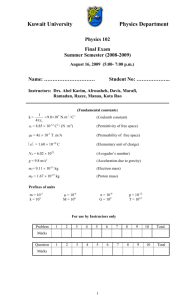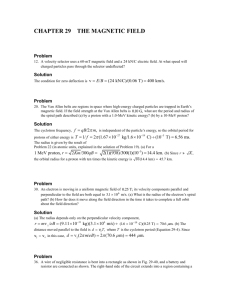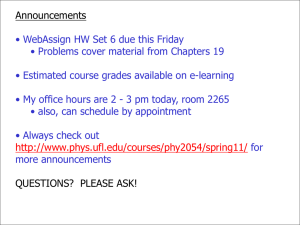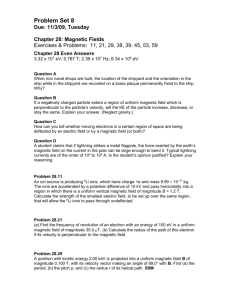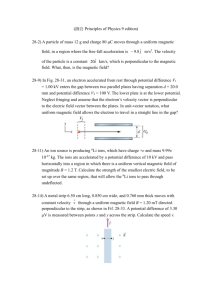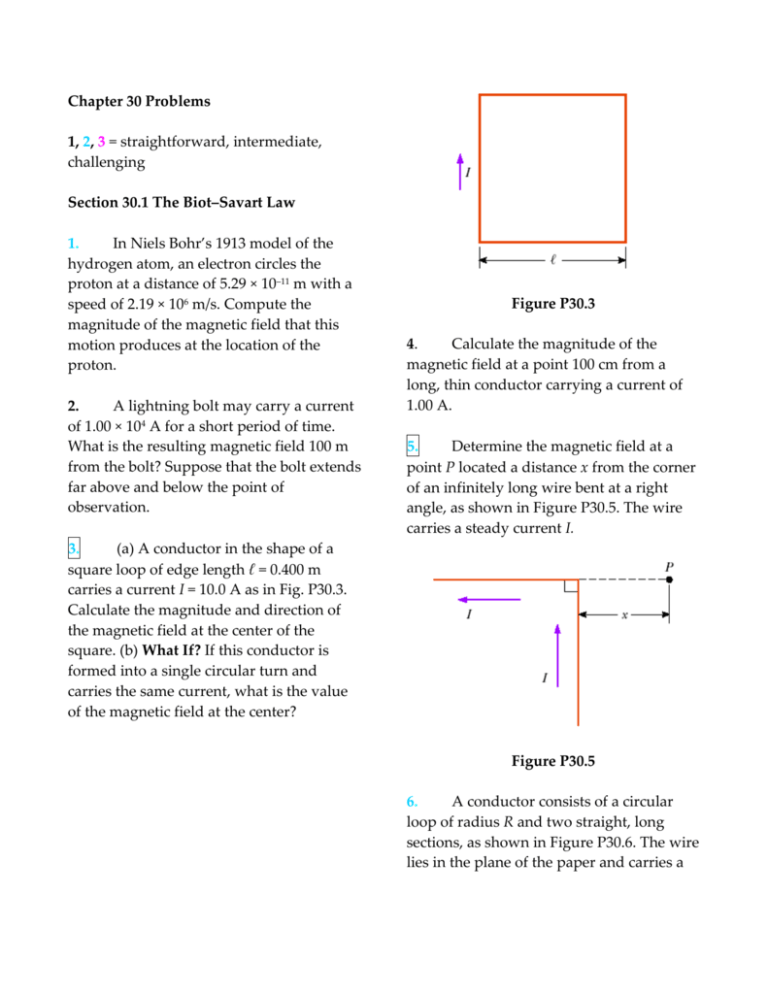
Chapter 30 Problems
1, 2, 3 = straightforward, intermediate,
challenging
Section 30.1 The Biot–Savart Law
1.
In Niels Bohr’s 1913 model of the
hydrogen atom, an electron circles the
proton at a distance of 5.29 × 10–11 m with a
speed of 2.19 × 106 m/s. Compute the
magnitude of the magnetic field that this
motion produces at the location of the
proton.
2.
A lightning bolt may carry a current
of 1.00 × 104 A for a short period of time.
What is the resulting magnetic field 100 m
from the bolt? Suppose that the bolt extends
far above and below the point of
observation.
Figure P30.3
4.
Calculate the magnitude of the
magnetic field at a point 100 cm from a
long, thin conductor carrying a current of
1.00 A.
5.
Determine the magnetic field at a
point P located a distance x from the corner
of an infinitely long wire bent at a right
angle, as shown in Figure P30.5. The wire
carries a steady current I.
3.
(a) A conductor in the shape of a
square loop of edge length ℓ = 0.400 m
carries a current I = 10.0 A as in Fig. P30.3.
Calculate the magnitude and direction of
the magnetic field at the center of the
square. (b) What If? If this conductor is
formed into a single circular turn and
carries the same current, what is the value
of the magnetic field at the center?
Figure P30.5
6.
A conductor consists of a circular
loop of radius R and two straight, long
sections, as shown in Figure P30.6. The wire
lies in the plane of the paper and carries a
current I. Find an expression for the vector
magnetic field at the center of the loop.
Figure P30.6
7.
The segment of wire in Figure P30.7
carries a current of I = 5.00 A, where the
radius of the circular arc is R = 3.00 cm.
Determine the magnitude and direction of
the magnetic field at the origin.
perpendicular to the page, as in Figure
P30.9. Wire 1 carries a current I1 into the
page (in the –z direction) and passes
through the x axis at x = +a. Wire 2 passes
through the x axis at x = –2a and carries an
unknown current I2. The total magnetic
field at the origin due to the currentcarrying wires has the magnitude
2μ0I1/(2πa). The current I2 can have either of
two possible values. (a) Find the value of I2
with the smaller magnitude, stating it in
terms of I1 and giving its direction. (b) Find
the other possible value of I2.
Figure P30.9
Figure P30.7
10.
A very long straight wire carries
current I. In the middle of the wire a rightangle bend is made. The bend forms an arc
of a circle of radius r, as shown in Figure
P30.10. Determine the magnetic field at the
center of the arc.
8.
Consider a flat circular current loop
of radius R carrying current I. Choose the x
axis to be along the axis of the loop, with
the origin at the center of the loop. Plot a
graph of the ratio of the magnitude of the
magnetic field at coordinate x to that at the
origin, for x = 0 to x = 5R. It may be useful to
use a programmable calculator or a
computer to solve this problem.
9.
Two very long, straight, parallel
wires carry currents that are directed
Figure P30.10
11.
One very long wire carries current
30.0 A to the left along the x axis. A second
very long wire carries current 50.0 A to the
right along the line (y = 0.280 m, z = 0). (a)
Where in the plane of the two wires is the
total magnetic field equal to zero? (b) A
particle with a charge of –2.00 μC is moving
with a velocity of 150î Mm/s along the line
(y = 0.100 m, z = 0). Calculate the vector
magnetic force acting on the particle. (c)
What If? A uniform electric field is applied
to allow this particle to pass through this
region undeflected. Calculate the required
vector electric field.
12.
Consider the current-carrying loop
shown in Figure P30.12, formed of radial
lines and segments of circles whose centers
are at point P. Find the magnitude and
direction of B at P.
14.
Determine the magnetic field (in
terms of I, a, and d) at the origin due to the
current loop in Figure P30.14.
Figure P30.14
15.
Two long, parallel conductors carry
currents I1 = 3.00 A and I2 = 3.00 A, both
directed into the page in Figure P30.15.
Determine the magnitude and direction of
the resultant magnetic field at P.
Figure P30.12
13.
A wire carrying a current I is bent
into the shape of an equilateral triangle of
side L. (a) Find the magnitude of the
magnetic field at the center of the triangle.
(b) At a point halfway between the center
and any vertex, is the field stronger or
weaker than at the center?
Figure P30.15
Section 30.2 The Magnetic Force Between
Two Parallel Conductors
16.
Two long, parallel conductors,
separated by 10.0 cm, carry currents in the
same direction. The first wire carries
current I1 = 5.00 A and the second carries I2
= 8.00 A. (a) What is the magnitude of the
magnetic field created by I1 at the location
of I2? (b) What is the force per unit length
exerted by I1 on I2? (c) What is the
magnitude of the magnetic field created by
I2 at the location of I1? (d) What is the force
per length exerted by I2 on I1?
17.
In Figure P30.17, the current in the
long, straight wire is I1 = 5.00 A and the
wire lies in the plane of the rectangular
loop, which carries the current I2 = 10.0 A.
The dimensions are c = 0.100 m, a = 0.150 m,
and ℓ = 0.450 m. Find the magnitude and
direction of the net force exerted on the
loop by the magnetic field created by the
wire.
Figure P30.17
18.
Two long, parallel wires are
attracted to each other by a force per unit
length of 320 μN/m when they are
separated by a vertical distance of 0.500 m.
The current in the upper wire is 20.0 A to
the right. Determine the location of the line
in the plane of the two wires along which
the total magnetic field is zero.
19.
Three long wires (wire 1, wire 2, and
wire 3) hang vertically. The distance
between wire 1 and wire 2 is 20.0 cm. On
the left, wire 1 carries an upward current of
1.50 A. To the right, wire 2 carries a
downward current of 4.00 A. Wire 3 is
located such that when it carries a certain
current, each wire experiences no net force.
Find (a) the position of wire 3, and (b) the
magnitude and direction of the current in
wire 3.
20.
The unit of magnetic flux is named
for Wilhelm Weber. The practical-size unit
of magnetic field is named for Johann Karl
Friedrich Gauss. Both were scientists at
Göttingen, Germany. Along with their
individual accomplishments, together they
built a telegraph in 1833. It consisted of a
battery and switch, at one end of a
transmission line 3 km long, operating an
electromagnet at the other end. (André
Ampère suggested electrical signaling in
1821; Samuel Morse built a telegraph line
between Baltimore and Washington in
1844.) Suppose that Weber and Gauss’s
transmission line was as diagrammed in
Figure P30.20. Two long, parallel wires,
each having a mass per unit length of 40.0
g/m, are supported in a horizontal plane by
strings 6.00 cm long. When both wires carry
the same current I, the wires repel each
other so that the angle θ between the
supporting strings is 16.0°. (a) Are the
currents in the same direction or in
opposite directions? (b) Find the magnitude
of the current.
Figure P30.20
Section 30.3 Ampère’s Law
21.
Four long, parallel conductors carry
equal currents of I = 5.00 A. Figure P30.21 is
an end view of the conductors. The current
direction is into the page at points A and B
(indicated by the crosses) and out of the
page at C and D (indicated by the dots).
Calculate the magnitude and direction of
the magnetic field at point P, located at the
center of the square of edge length 0.200 m.
22.
A long straight wire lies on a
horizontal table and carries a current of 1.20
μA. In a vacuum, a proton moves parallel
to the wire (opposite the current) with a
constant speed of 2.30 × 104 m/s at a
distance d above the wire. Determine the
value of d. You may ignore the magnetic
field due to the Earth.
23.
Figure P30.23 is a cross-sectional
view of a coaxial cable. The center
conductor is surrounded by a rubber layer,
which is surrounded by an outer conductor,
which is surrounded by another rubber
layer. In a particular application, the
current in the inner conductor is 1.00 A out
of the page and the current in the outer
conductor is 3.00 A into the page.
Determine the magnitude and direction of
the magnetic field at points a and b.
Figure P30.23
Figure P30.21
24.
The magnetic field 40.0 cm away
from a long straight wire carrying current
2.00 A is 1.00 μT. (a) At what distance is it
0.100 μT? (b) What If? At one instant, the
two conductors in a long household
extension cord carry equal 2.00-A currents
in opposite directions. The two wires are
3.00 mm apart. Find the magnetic field 40.0
cm away from the middle of the straight
cord, in the plane of the two wires. (c) At
what distance is it one tenth as large? (d)
The center wire in a coaxial cable carries
current 2.00 A in one direction and the
sheath around it carries current 2.00 A in
the opposite direction. What magnetic field
does the cable create at points outside?
25.
A packed bundle of 100 long,
straight, insulated wires forms a cylinder of
radius R = 0.500 cm. (a) If each wire carries
2.00 A, what are the magnitude and
direction of the magnetic force per unit
length acting on a wire located 0.200 cm
from the center of the bundle? (b) What If?
Would a wire on the outer edge of the
bundle experience a force greater or smaller
than the value calculated in part (a)?
26.
The magnetic coils of a tokamak
fusion reactor are in the shape of a toroid
having an inner radius of 0.700 m and an
outer radius of 1.30 m. The toroid has 900
turns of large-diameter wire, each of which
carries a current of 14.0 kA. Find the
magnitude of the magnetic field inside the
toroid along (a) the inner radius and (b) the
outer radius.
27.
Consider a column of electric current
passing through plasma (ionized gas).
Filaments of current within the column are
magnetically attracted to one another. They
can crowd together to yield a very great
current density and a very strong magnetic
field in a small region. Sometimes the
current can be cut off momentarily by this
pinch effect. (In a metallic wire a pinch effect
is not important, because the currentcarrying electrons repel one another with
electric forces.) The pinch effect can be
demonstrated by making an empty
aluminum can carry a large current parallel
to its axis. Let R represent the radius of the
can and I the upward current, uniformly
distributed over its curved wall. Determine
the magnetic field (a) just inside the wall
and (b) just outside. (c) Determine the
pressure on the wall.
28.
Niobium metal becomes a
superconductor when cooled below 9 K. Its
superconductivity is destroyed when the
surface magnetic field exceeds 0.100 T.
Determine the maximum current a 2.00mm-diameter niobium wire can carry and
remain superconducting, in the absence of
any external magnetic field.
29.
A long cylindrical conductor of
radius R carries a current I as shown in
Figure P30.29. The current density J,
however, is not uniform over the cross
section of the conductor but is a function of
the radius according to J = br, where b is a
constant. Find an expression for the
magnetic field B (a) at a distance r1 < R and
(b) at a distance r2 > R, measured from the
axis.
solenoid a magnetic field of magnitude 1.00
× 10–4 T?
Figure P30.29
30.
In Figure P30.30, both currents in the
infinitely long wires are in the negative x
direction. (a) Sketch the magnetic field
pattern in the yz plane. (b) At what distance
d along the z axis is the magnetic field a
maximum?
32.
Consider a solenoid of length ℓ and
radius R, containing N closely spaced turns
and carrying a steady current I. (a) In terms
of these parameters, find the magnetic field
at a point along the axis as a function of
distance a from the end of the solenoid. (b)
Show that as ℓ becomes very long, B
approaches μ0NI/2ℓ at each end of the
solenoid.
33.
A single-turn square loop of wire,
2.00 cm on each edge, carries a clockwise
current of 0.200 A. The loop is inside a
solenoid, with the plane of the loop
perpendicular to the magnetic field of the
solenoid. The solenoid has 30 turns/cm and
carries a clockwise current of 15.0 A. Find
the force on each side of the loop and the
torque acting on the loop.
Section 30.5 Magnetic Flux
Figure P30.30
Section 30.4 The Magnetic Field of a
Solenoid
31.
What current is required in the
windings of a long solenoid that has 1 000
turns uniformly distributed over a length of
0.400 m, to produce at the center of the
34.
Consider the hemispherical closed
surface in Figure P30.34. The hemisphere is
in a uniform magnetic field that makes an
angle θ with the vertical. Calculate the
magnetic flux through (a) the flat surface S1
and (b) the hemispherical surface S2.
36.
A solenoid 2.50 cm in diameter and
30.0 cm long has 300 turns and carries 12.0
A. (a) Calculate the flux through the surface
of a disk of radius 5.00 cm that is positioned
perpendicular to and centered on the axis
of the solenoid, as shown in Figure P30.36a.
(b) Figure P30.36b shows an enlarged end
view of the same solenoid. Calculate the
flux through the blue area, which is defined
by an annulus that has an inner radius of
0.400 cm and outer radius of 0.800 cm.
Figure P30.34
35.
A cube of edge length ℓ = 2.50 cm is
positioned as shown in Figure P30.35. A
^
uniform magnetic field given by B = (5 i +
^
^
4 j + 3 k )T exists throughout the region. (a)
Calculate the flux through the shaded face.
(b) What is the total flux through the six
faces?
Figure P30.36
Section 30.7 Displacement Current and
the General Form of Ampère’s Law
Figure P30.35
37.
A 0.100-A current is charging a
capacitor that has square plates 5.00 cm on
each side. The plate separation is 4.00 mm.
Find (a) the time rate of change of electric
flux between the plates and (b) the
displacement current between the plates.
38.
A 0.200-A current is charging a
capacitor that has circular plates 10.0 cm in
radius. If the plate separation is 4.00 mm,
(a) what is the time rate of increase of
electric field between the plates? (b) What is
the magnetic field between the plates 5.00
cm from the center?
Section 30.8 Magnetism in Matter
39.
In Bohr’s 1913 model of the
hydrogen atom, the electron is in a circular
orbit of radius 5.29 × 10–11 m and its speed is
2.19 × 106 m/s. (a) What is the magnitude of
the magnetic moment due to the electron’s
motion? (b) If the electron moves in a
horizontal circle, counterclockwise as seen
from above, what is the direction of this
magnetic moment vector?
40.
A magnetic field of 1.30 T is to be set
up in an iron-core toroid. The toroid has a
mean radius of 10.0 cm, and magnetic
permeability of 5 000 μ0. What current is
required if the winding has 470 turns of
wire? The thickness of the iron ring is small
compared to 10 cm, so the field in the
material is nearly uniform.
41.
A toroid with a mean radius of 20.0
cm and 630 turns (see Fig. 30.30) is filled
with powdered steel whose magnetic
susceptibility χ is 100. The current in the
windings is 3.00 A. Find B (assumed
uniform) inside the toroid.
42.
A particular paramagnetic substance
achieves 10.0% of its saturation
magnetization when placed in a magnetic
field of 5.00 T at a temperature of 4.00 K.
The density of magnetic atoms in the
sample is 8.00 × 1027 atoms/m3, and the
magnetic moment per atom is 5.00 Bohr
magnetons. Calculate the Curie constant for
this substance.
43.
Calculate the magnetic field strength
H of a magnetized substance in which the
magnetization is 0.880 × 106 A/m and the
magnetic field has magnitude 4.40 T.
44.
At saturation, when nearly all of the
atoms have their magnetic moments
aligned, the magnetic field in a sample of
iron can be 2.00 T. If each electron
contributes a magnetic moment of 9.27 ×
10-24 A · m2 (one Bohr magneton), how
many electrons per atom contribute to the
saturated field of iron? Iron contains
approximately 8.50 × 1028 atoms/m3.
45. (a) Show that Curie’s law can be stated
in the following way: The magnetic
susceptibility of a paramagnetic substance
is inversely proportional to the absolute
temperature, according to χ = Cμ0/T, where
C is Curie’s constant. (b) Evaluate Curie’s
constant for chromium.
Section 30.9 The Magnetic Field of the
Earth
46.
A circular coil of 5 turns and a
diameter of 30.0 cm is oriented in a vertical
plane with its axis perpendicular to the
horizontal component of the Earth’s
magnetic field. A horizontal compass
placed at the center of the coil is made to
deflect 45.0° from magnetic north by a
current of 0.600 A in the coil. (a) What is the
horizontal component of the Earth’s
magnetic field? (b) The current in the coil is
switched off. A “dip needle” is a magnetic
compass mounted so that it can rotate in a
vertical north–south plane. At this location
a dip needle makes an angle of 13.0° from
the vertical. What is the total magnitude of
the Earth’s magnetic field at this location?
47.
The magnetic moment of the Earth is
approximately 8.00 × 1022 A · m2. (a) If this
were caused by the complete magnetization
of a huge iron deposit, how many unpaired
electrons would this correspond to? (b) At
two unpaired electrons per iron atom, how
many kilograms of iron would this
correspond to? (Iron has a density of 7 900
kg/m3, and approximately 8.50 × 1028 iron
atoms/m3.)
Additional Problems
48.
The magnitude of the Earth’s
magnetic field at either pole is
approximately 7.00 × 10–5 T. Suppose that
the field fades away, before its next
reversal. Scouts, sailors, and conservative
politicians around the world join together
in a program to replace the field. One plan
is to use a current loop around the equator,
without relying on magnetization of any
materials inside the Earth. Determine the
current that would generate such a field if
this plan were carried out. (Take the radius
of the Earth as RE = 6.37 × 106 m.)
49.
A very long, thin strip of metal of
width w carries a current I along its length
as shown in Figure P30.49. Find the
magnetic field at the point P in the diagram.
The point P is in the plane of the strip at
distance b away from it.
Figure P30.49
50.
Suppose you install a compass on
the center of the dashboard of a car.
Compute an order-of-magnitude estimate
for the magnetic field at this location
produced by the current when you switch
on the headlights. How does it compare
with the Earth’s magnetic field? You may
suppose the dashboard is made mostly of
plastic.
51.
For a research project, a student
needs a solenoid that produces an interior
magnetic field of 0.030 0 T. She decides to
use a current of 1.00 A and a wire 0.500 mm
in diameter. She winds the solenoid in
layers on an insulating form 1.00 cm in
diameter and 10.0 cm long. Determine the
number of layers of wire needed and the
total length of the wire.
52.
A thin copper bar of length ℓ = 10.0
cm is supported horizontally by two
(nonmagnetic) contacts. The bar carries
current I1 = 100 A in the –x direction, as
shown in Figure P30.52. At a distance h =
0.500 cm below one end of the bar, a long
straight wire carries a current I2 = 200 A in
the z direction. Determine the magnetic
force exerted on the bar.
ring. What is the magnitude of the magnetic
field on the axis of the ring a distance R/2
from its center?
55.
Two circular coils of radius R, each
with N turns, are perpendicular to a
common axis. The coil centers are a
distance R apart. Each coil carries a steady
current I in the same direction, as shown in
Figure P30.55. (a) Show that the magnetic
field on the axis at a distance x from the
center of one coil is
B
N 0 IR 2
2
1
1
2
3
/
2
3
/
2
2R 2 x 2 2Rx
R x 2
(b) Show that dB/dx and d2B/dx2 are both
zero at the point midway between the coils.
This means the magnetic field in the region
midway between the coils is uniform. Coils
in this configuration are called Helmholtz
coils.
Figure P30.52
53.
A nonconducting ring of radius 10.0
cm is uniformly charged with a total
positive charge 10.0 μC. The ring rotates at
a constant angular speed 20.0 rad/s about
an axis through its center, perpendicular to
the plane of the ring. What is the
magnitude of the magnetic field on the axis
of the ring 5.00 cm from its center?
54.
A nonconducting ring of radius R is
uniformly charged with a total positive
charge q. The ring rotates at a constant
angular speed ω about an axis through its
center, perpendicular to the plane of the
Figure P30.55
56.
Two identical, flat, circular coils of
wire each have 100 turns and a radius of
0.500 m. The coils are arranged as a set of
Helmholtz coils (see Fig. P30.55), parallel
and with separation 0.500 m. Each coil
carries a current of 10.0 A. Determine the
magnitude of the magnetic field at a point
on the common axis of the coils and
halfway between them.
57.
We have seen that a long solenoid
produces a uniform magnetic field directed
along the axis of a cylindrical region.
However, to produce a uniform magnetic
field directed parallel to a diameter of a
cylindrical region, one can use the saddle
coils illustrated in Figure P30.57. The loops
are wrapped over a somewhat flattened
tube. Assume the straight sections of wire
are very long. The end view of the tube
shows how the windings are applied. The
overall current distribution is the
superposition of two overlapping circular
cylinders of uniformly distributed current,
one toward you and one away from you.
The current density J is the same for each
cylinder. The position of the axis of one
cylinder is described by a position vector a
relative to the other cylinder. Prove that the
magnetic field inside the hollow tube is
μ0Ja/2 downward. Suggestion: The use of
vector methods simplifies the calculation.
Figure P30.57: (a) General view of one turn
of each saddle coil. b) End view of the coils
carrying current into the paper on the left
and out of the paper on the right.
58.
A very large parallel-plate capacitor
carries charge with uniform charge per unit
area +σ on the upper plate and –σ on the
lower plate. The plates are horizontal and
both move horizontally with speed v to the
right. (a) What is the magnetic field
between the plates? (b) What is the
magnetic field close to the plates but
outside of the capacitor? (c) What is the
magnitude and direction of the magnetic
force per unit area on the upper plate? (d)
At what extrapolated speed v will the
magnetic force on a plate balance the
electric force on the plate? Calculate this
speed numerically.
59.
Two circular loops are parallel,
coaxial, and almost in contact, 1.00 mm
apart (Fig. P30.59). Each loop is 10.0 cm in
radius. The top loop carries a clockwise
current of 140 A. The bottom loop carries a
counterclockwise current of 140 A. (a)
Calculate the magnetic force exerted by the
bottom loop on the top loop. (b) The upper
loop has a mass of 0.021 0 kg. Calculate its
acceleration, assuming that the only forces
acting on it are the force in part (a) and the
gravitational force. Suggestion: Think about
how one loop looks to a bug perched on the
other loop.
Figure P30.59
60.
What objects experience a force in an
electric field? Chapter 23 gives the answer:
any electric charge, stationary or moving,
other than the charge that created the field.
What creates an electric field? Any electric
charge, stationary or moving, as you
studied in Chapter 23. What objects
experience a force in a magnetic field? An
electric current or a moving electric charge,
other than the current or charge that
created the field, as discussed in Chapter
29. What creates a magnetic field? An
electric current, as you studied in Section
30.1, or a moving electric charge, as shown
in this problem. (a) To display how a
moving charge creates a magnetic field,
consider a charge q moving with velocity v.
^
Define the vector r = r r to lead from the
charge to some location. Show that the
magnetic field at that location is
^
qv r
B 0
4 r 2
(b) Find the magnitude of the magnetic
field 1.00 mm to the side of a proton
moving at 2.00 × 107 m/s. (c) Find the
magnetic force on a second proton at this
point, moving with the same speed in the
opposite direction. (d) Find the electric
force on the second proton.
61.
Rail guns have been suggested for
launching projectiles into space without
chemical rockets, and for ground-to-air
antimissile weapons of war. A tabletop
model rail gun (Fig. P30.61) consists of two
long parallel horizontal rails 3.50 cm apart,
bridged by a bar BD of mass 3.00 g. The bar
is originally at rest at the midpoint of the
rails and is free to slide without friction.
When the switch is closed, electric current
is quickly established in the circuit
ABCDEA. The rails and bar have low
electric resistance, and the current is limited
to a constant 24.0 A by the power supply.
(a) Find the magnitude of the magnetic
field 1.75 cm from a single very long
straight wire carrying current 24.0 A. (b)
Find the magnitude and direction of the
magnetic field at point C in the diagram,
the midpoint of the bar, immediately after
the switch is closed. Suggestion: Consider
what conclusions you can draw from the
Biot–Savart law. (c) At other points along
the bar BD, the field is in the same direction
as at point C, but larger in magnitude.
Assume that the average effective magnetic
field along BD is five times larger than the
field at C. With this assumption, find the
magnitude and direction of the force on the
bar. (d) Find the acceleration of the bar
when it is in motion. (e) Does the bar move
with constant acceleration? (f) Find the
velocity of the bar after it has traveled 130
cm to the end of the rails.
Figure P30.61
62.
Fifty turns of insulated wire 0.100 cm
in diameter are tightly wound to form a flat
spiral. The spiral fills a disk surrounding a
circle of radius 5.00 cm and extending to a
radius 10.00 cm at the outer edge. Assume
the wire carries current I at the center of its
cross section. Approximate each turn of
wire as a circle. Then a loop of current
exists at radius 5.05 cm, another at 5.15 cm,
and so on. Numerically calculate the
magnetic field at the center of the coil.
63.
Two long, parallel conductors carry
currents in the same direction as shown in
Figure P30.63. Conductor A carries a
current of 150 A and is held firmly in
position. Conductor B carries a current IB
and is allowed to slide freely up and down
(parallel to A) between a set of
nonconducting guides. If the mass per unit
length of conductor B is 0.100 g/cm, what
value of current IB will result in equilibrium
when the distance between the two
conductors is 2.50 cm?
between the rollers as shown. The charge is
removed by a wiper at the right-hand
roller. Consider a point just above the
surface of the moving belt. (a) Find an
expression for the magnitude of the
magnetic field B at this point. (b) If the belt
is positively charged, what is the direction
of B? (Note that the belt may be considered
as an infinite sheet.)
Figure P30.64
65.
An infinitely long straight wire
carrying a current I1 is partially surrounded
by a loop as shown in Figure P30.65. The
loop has a length L, radius R, and carries a
current I2. The axis of the loop coincides
with the wire. Calculate the force exerted
on the loop.
Figure P30.63
64.
Charge is sprayed onto a large
nonconducting belt above the left-hand
roller in Figure P30.64. The belt carries the
charge with a uniform surface charge
density σ as it moves with a speed v
Figure P30.67
Figure P30.65
66.
Measurements of the magnetic field
of a large tornado were made at the
Geophysical Observatory in Tulsa,
Oklahoma, in 1962. The tornado’s field was
measured to be B = 1.50 × 10–8 T pointing
north when the tornado was 9.00 km east of
the observatory. What current was carried
up or down the funnel of the tornado,
modeled as a long straight wire?
67.
A wire is formed into the shape of a
square of edge length L (Fig. P30.67). Show
that when the current in the loop is I, the
magnetic field at point P, a distance x from
the center of the square along its axis is
B
0 IL2
2 x 2 L2 / 4 x 2 L2 / 2
68.
The force on a magnetic dipole μ
aligned with a nonuniform magnetic field
in the x direction is given by Fx = |μ|dB/dx.
Suppose that two flat loops of wire each
have radius R and carry current I. (a) The
loops are arranged coaxially and separated
by a variable distance x, large compared to
R. Show that the magnetic force between
them varies as 1/x4. (b) Evaluate the
magnitude of this force if I = 10.0 A, R =
0.500 cm, and x = 5.00 cm.
69.
A wire carrying a current I is bent
into the shape of an exponential spiral, r =
eθ, from θ = 0 to θ = 2π as shown in Figure
P30.69. To complete a loop, the ends of the
spiral are connected by a straight wire
along the x axis. Find the magnitude and
direction of B at the origin. Suggestions: Use
the Biot–Savart law. The angle β between a
radial line and its tangent line at any point
on the curve r = f (θ) is related to the
function in the following way:
tan
r
dr / d
Thus in this case r = eθ, tan β = 1 and β = π/4.
^
Therefore, the angle between ds and r is π
– β = 3π/4. Also
ds
dr
sin / 4
2 dr
71.
A sphere of radius R has a uniform
volume charge density ρ. Determine the
magnetic field at the center of the sphere
when it rotates as a rigid object with
angular speed ω about an axis through its
center (Fig. P30.71).
Figure P30.69
70.
Table P30.70 contains data taken for
a ferromagnetic material. (a) Construct a
magnetization curve from the data.
Remember that B = B0 + μ0M. (b) Determine
the ratio B/B0 for each pair of values of B
and B0, and construct a graph of B/B0 versus
B0. (The fraction B/B0 is called the relative
permeability, and it is a measure of the
induced magnetic field.)
B (T)
0.2
0.4
0.6
0.8
1.0
1.2
1.4
1.6
1.8
B0 (T)
4.8 × 10–5
7.0 × 10–5
8.8 × 10–5
1.2 × 10–4
1.8 × 10–4
3.1 × 10–4
8.7 × 10–4
3.4 × 10–3
1.2 × 10–1
Figure P30.71
72.
A sphere of radius R has a uniform
volume charge density ρ. Determine the
magnetic dipole moment of the sphere
when it rotates as a rigid body with angular
velocity ω about an axis through its center
(Fig. P30.71).
73.
A long cylindrical conductor of
radius a has two cylindrical cavities of
diameter a through its entire length, as
shown in Figure P30.73. A current I is
directed out of the page and is uniform
through a cross section of the conductor.
Find the magnitude and direction of the
magnetic field in terms of μ0, I, r, and a at
(a) point P1 and (b) point P2.
Figure P30.73
© Copyright 2004 Thomson. All rights reserved.


